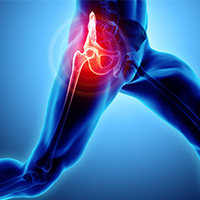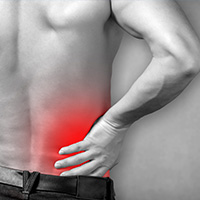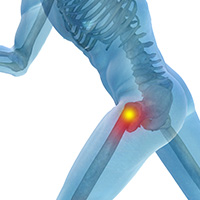Existing Patients
(410) 650-9804
New Patients
(410) 826-6528

Hip arthritis is inflammation in the hip joint. This can either be in the form of osteoarthritis, which mostly comes from wear and tear, or rheumatoid arthritis, which is an autoimmune condition.

The unfortunate truth is that there is no cure for arthritis. The goal of treatment is to provide relief from its symptoms, prevent further joint destruction and enable you to remain active.
Nonsurgical treatment for hip osteoarthritis and inflammatory arthritis in the hip can include the following:
Bursitis is a condition that occurs when the bursa (fluid-filled sacs near the joints) become irritated and swollen. The bursa is responsible for cushioning the pressure points between the bones, tendons, muscles and skin near the joints.
Bursitis in the hip occurs when the bursa on the groin side of the hip becomes inflamed. The pain can be felt in the groin but it is caused by a condition in the hip.

Hip tendonitis is inflammation and degeneration in the tendons, which are the thick cords that attach muscles to the hip bone. This is typically due to overuse.
The iliac muscle starts in the hip bone, and the psoas muscle starts in the lower spine. These muscles come together in a tendon at the top of the femur, and this is where tendonitis in the hip occurs.
Hip tendonitis typically occurs when the tendon is under abnormal stress from activity that you are not used to doing. Hip tendonitis is a degenerative injury that causes a disorientation in the tendon fibers.
The most common symptom of hip tendonitis is pain that develops gradually over time.
Other symptoms of hip tendonitis can include:
Pain and inflammation in the hip joint are the main reasons that doctors prescribe steroid injections. A steroid injection contains two main ingredients; the first is a steroid (cortisone) that helps reduce inflammation, and the second is a numbing agent or anesthetic that reduces pain.
In some cases, cortisone may cause the cartilage in the hip joint to break down over time. Our practitioners may therefore limit the number of steroid injections you can get and may spread them out over several weeks.
In addition to relieving pain, steroid injections are sometimes used to diagnose your condition. If the injection fails to provide relief, the practitioner knows that the source of pain is from somewhere other than your hip.

Our practitioner will perform the steroid injection in our office using a specialized type of X-ray, known as a fluoroscope. This devise will project an image of the inside of your hip onto a screen, and it enables the practitioner to identify where to place the needle most effectively.
The practitioner will first clean the area and apply a local anesthetic to numb the area. The needle will be inserted into your hip joint while the practitioner monitors the fluoroscope screen. The practitioner may inject a dye to make it easier to see where to inject the steroid.
After the injection, you will stay in place for several minutes and then move your hip to let the practitioner know if you still feel pain. You may feel some soreness as the numbing agent wears off. Once the steroid takes effect over the next several days, you will notice the pain wearing off.
How long the treatment lasts varies from person to person. You can expect it to provide relief for weeks or months, depending on a number of other factors, including lifestyle, overall health, genetics, age, and severity of the condition.
Platelet-rich plasma (PRP) is a form of regenerative therapy that helps you manage pain in joints, tendons, ligaments and other pressure areas. This procedure uses your body's own healing properties to treat pain and stimulate healing.
Before you consider surgery for managing hip pain and other injuries, you should explore all non-surgical options. PRP is minimally invasive and is effective in treating pain in your hips and restoring function and range of motion.
Your blood is made up of platelets and white and red blood cells. Platelets help with clotting when you get a cut, and they also contain proteins and growth factors that help in the healing process. Plasma is the liquid part of your blood, and “platelet-rich plasma” contains a higher concentration of platelets than normal blood does.
Before your appointment, our practitioner may give you instructions such as stopping anti-coagulant, steroid and NSAID medications. You should also drink plenty of water in the days just before your appointment.
At your appointment, the practitioner will draw a vial of your blood, which is run through a centrifuge for approximately five to ten minutes. The centrifuge spins very fast to separate the components of your blood.
Next, they clean the skin and use fluoroscopic imaging to see inside your body and help guide the needle. The goal is to inject the PRP infusion directly into the injured part of your hip.
You may experience some soreness in your hip following the procedure. Use cold compresses to ease the pain. If the practitioner determines that multiple rounds of PRP treatment are needed, they will be administered four to six weeks apart.
People suffering from pain in the ligaments, tendons, muscles, bones and cartilage in the hips benefit from PRP injections. This includes people who suffered an injury or have a degenerative condition. Common conditions treated with PRP injections are:
